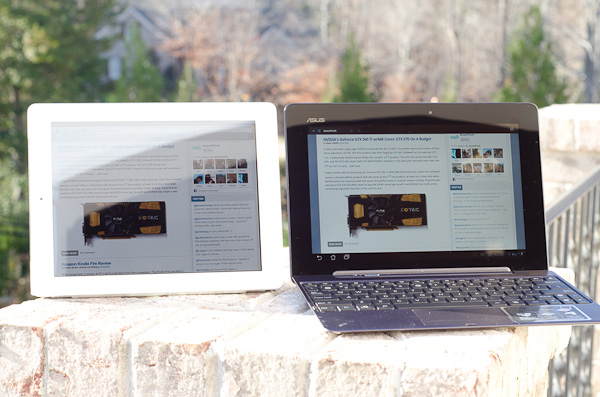ASUS Eee Pad Transformer Prime Review Part II: Battery Life & More
by Anand Lal Shimpi on December 15, 2011 3:45 AM ESTSuper IPS+
I rode around town as a passenger equipped with the Transformer Prime and dock to test out how usable the setup was as a truly mobile platform. Glare is still a big issue if you're in a sunny environment; however, I was surprised to see that even without engaging the Prime's Super IPS+ mode that the display was usable in many cases outdoors. I definitely preferred the experience with Super IPS+ mode enabled though. While the glossy screen picks up fingerprints and is extremely reflective, the 600+ nits the panel is able to put out in its brightest mode definitely overcome both of these concerns.

Color Gamut
Some of you have asked for color gamut charts for the Transformer Prime, which I have provided below vs. the original Transformer:

ASUS Eee Pad Transformer

ASUS Eee Pad Transformer Prime










58 Comments
View All Comments
kenyee - Thursday, December 15, 2011 - link
I'm not sure this would show up in the color gamut tests because the original Transformer had an 18-bit dithered screen...lordmetroid - Thursday, December 15, 2011 - link
Can I install whatever operating system I want?jllcmu04@hotmail.com - Thursday, December 15, 2011 - link
Hi,First off, I am very happy for your thoroughness. You always try your best in your reviews. My trouble is with your CONSTANT comparison to mac book air. How expensive is your mac book air, and what processor and hd etc come with it? Even if you take the 64 GB model TF-Prime, you are still easily a couple hundred under MBA. Also, as you mentioned, one is a tablet + dock , while the other is designed, albeit very very well, as a laptop. Now the comparison to netbooks is one I can understand, but the constant comparison to MBA I feel degrades from true evaluation. One thing I found funny, is that even with the comparison to a system that is much more expensive, it still is able to keep up some.
Anyway, thanks for a great review!
J
Graag - Thursday, December 15, 2011 - link
"Now the comparison to netbooks is one I can understand, but the constant comparison to MBA I feel degrades from true evaluation."I think that comparisons like this are actually very helpful, since there are a decent number of people who want to know whether they need a MBA/Ultrabook, or whether they can save $400-$500 and use a tablet. And, particularly because tablets are still pretty new (as mainstream devices, anyway), it's also useful to delineate the boundaries between laptops and tablets.
"One thing I found funny, is that even with the comparison to a system that is much more expensive, it still is able to keep up some."
This is a very important point for some users - and a point that wouldn't have been made but for comparing the tablet to a MBA.
DanNeely - Thursday, December 15, 2011 - link
There's not a major ultraportable laptop platform between netbooks and the mba. Some of the cheaper ultrabooks might drop into it but none are there in meaningful volumes yet.justaviking - Thursday, December 15, 2011 - link
I cannot get your video to load."An error has occured, please try again later."
vision33r - Thursday, December 15, 2011 - link
1.4GHZ Tegra 3 is barely faster than the iPad 2 and we know that thing only runs at 1GHZ.By March, we know the A6 will be quad-core and most likely run at 1.2GHZ and Apple always make a huge performance leap just to keep the device potent enough for a whole year.
Why would anyone want to buy the TF Prime that will be the fastest Android tab for about 3 month for $500
Samsung will have their own quad-core Exynos out soon too.
iPad 3 will also have a 200ppi display which will make every other tablet look like a pixel board.
This is not an Apple fan post, just stating the what the competition will be and Tegra 3 is a very small upgrade.
eddman - Thursday, December 15, 2011 - link
No, It should read "transformer prime is barely faster than the iPad 2".There is no way tegra 3 is slower than A5, it's the software. While ios is fully optimized for A5, honeycomb can't even utilize dual-core chips properly. Let's see what ICS would do.
Personally, I'm waiting for windows 8 tablets.
shady28 - Friday, December 23, 2011 - link
A lot of semantics there. True that A5 is probably slower than Tegra 3, but also from the article there is no significant performance difference between an iPad 2 vs Transformer Prime. The OS and platform do count.
I'm a bit disappointed too though. I really thought the quad core Tegra 3 would be at least 40% or so faster than similar clocked A9 based systems just because of the extra 2 processors, but apparently not. I'm thinking maybe Android isn't quite optimized for more than 2 cores yet.
IntelUser2000 - Thursday, December 15, 2011 - link
"Whereas the move from one to two cores was instantly noticeable on Android phones, the move from two to four is understandably less appreciable."It looks like 4 core is for the forseeable future a practical limit for the "multi-core" era before we opt for another approach.
The gains in battery life in web browsing and video playback is likely not due to having extra cores and being able to clock them down faster, but the more advanced power saving available in Tegra 3.
They noted something similar to Intel's DPST(Display Power Saving Technology), along with better C states compared to Tegra 2.